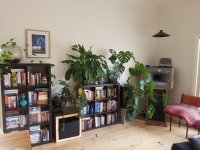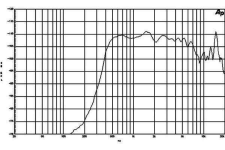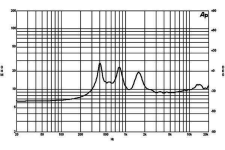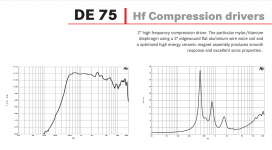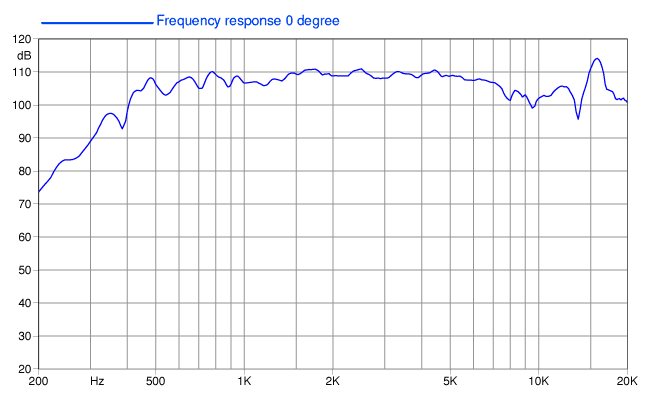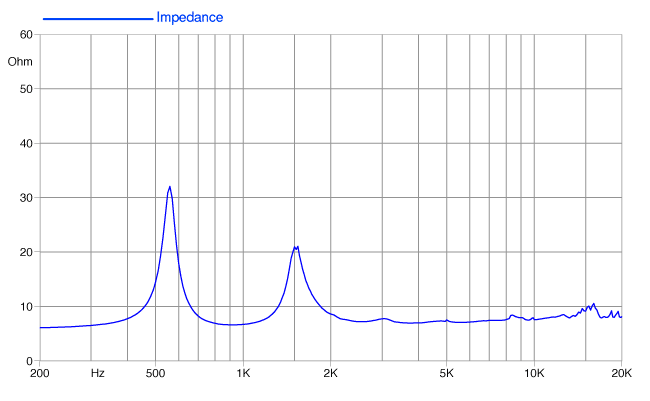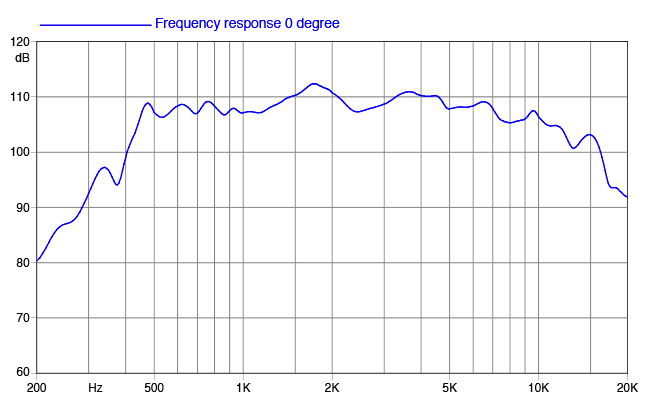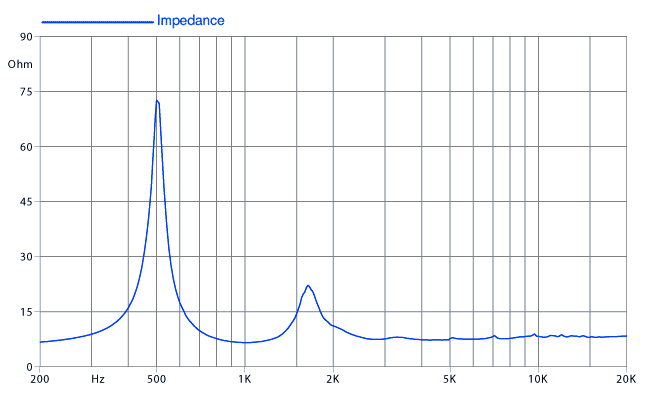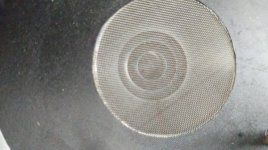I've actually listened to both horns over an extended time period using a variety of EQ configurations in each case. There is something other than EQ which is audible. I attribute it to the exact horn profiles.
Thanks for the info.
Based on that, of my affordable / obtainable options, making something myself seems to be the better choice (cos the flat walls).
That's my takeaway based on my K-402 and K-510 listening experience vs. other horn profiles. I suppose that any dual-flare straight-sided horn will be an improvement on the sound quality over curved-wall horns (curved in the throat area of the horn).
I think that Geddes gave an explanation here why that's the case, and why Webster's 1D formula doesn't apply to horn performance once the horn wall curves away from the throat such that an observer looking at toward the throat sees nothing but horn wall instead of the throat of the driver.
Chris
I think that Geddes gave an explanation here why that's the case, and why Webster's 1D formula doesn't apply to horn performance once the horn wall curves away from the throat such that an observer looking at toward the throat sees nothing but horn wall instead of the throat of the driver.
Chris
OK.
Looks like I can replace / rebuild this system (pictured: 80cm wide horn + bass box) as a single box straight-walled MEH.
Single box: because the 2-box stack has poor space efficiency, with ~120 litres of wasted volume behind the horn.
Straight wall: partly based on Chris' advice, partly for ease of build.
MEH: partly out of interest and partly cos the current sound is let down (especially in the current room) by the low mids & bass.
As the photo indicates, it is a fairly big living room, not a dedicated audio room (or man cave), with plenty of hard surfaces. One wall is mostly glass. The LF sound quality changes hugely as the speaker moves; the corner is much better than a previous spot.
While the dimensions of the current horn are OK (80cm width), my GF doesn't love the industrial aesthetic. I want to build with ply & apply a pretty skin of 5mm bamboo (non bendy), hence simple = good (the fewer angles I have to do, the better). The secondary expansion would be a hand-shaped roundover to a laminated panel, like in this project, which is the nicest effect I can get without having l334 woodwork ski||z.
I chose the dimensions + angles below (by trial and error) to get a simple horn with reasonable angles that can be cut using router bits I already own (the angle z = 45 degrees, 'r' = 22.5 degrees).
FULL SIZE, SINGLE EXPANSION VERSION
90 degrees - horizontal
65.52 degrees - vertical
400Hz - horizontal pattern control (vertical should be ~600Hz)
31mm throat (shape to 44mm round - this is ~actual driver size if measuring to the middle of the surround)
SIDES:
A Throat: 31.2mm
C Mouth: 386.8mm
B Length: 394.6mm
TOP & BOTTOM:
A Throat: 31.2mm
G Mouth: 585.8mm
E Length: 331.8mm
OVERALL SIZE:
Width: 585.8mm
Height: 386.8mm
Depth: 279mm
Syncalc + Hornresp tell me I should be OK going 2-way (crossed at 500-700Hz) using the 2" Tympany driver plus a quad of 6.5" woofers. The Tmmphany SDS-160F25PR01-08 are cheap, only 1kg each, and would work well with ~30 litres each. It looks like I could cross them (digital filter) anywhere from 500Hz to 1kHz.
Does all of that seem reasonable?
Another 'easy' option (using drivers I already own) would be a 3-way with a dome or 1" CD at the apex, and a couple of 3" mids per box, but I can't see what that'd gain me over the 2-way option.
Looks like I can replace / rebuild this system (pictured: 80cm wide horn + bass box) as a single box straight-walled MEH.
Single box: because the 2-box stack has poor space efficiency, with ~120 litres of wasted volume behind the horn.
Straight wall: partly based on Chris' advice, partly for ease of build.
MEH: partly out of interest and partly cos the current sound is let down (especially in the current room) by the low mids & bass.
As the photo indicates, it is a fairly big living room, not a dedicated audio room (or man cave), with plenty of hard surfaces. One wall is mostly glass. The LF sound quality changes hugely as the speaker moves; the corner is much better than a previous spot.
While the dimensions of the current horn are OK (80cm width), my GF doesn't love the industrial aesthetic. I want to build with ply & apply a pretty skin of 5mm bamboo (non bendy), hence simple = good (the fewer angles I have to do, the better). The secondary expansion would be a hand-shaped roundover to a laminated panel, like in this project, which is the nicest effect I can get without having l334 woodwork ski||z.
I chose the dimensions + angles below (by trial and error) to get a simple horn with reasonable angles that can be cut using router bits I already own (the angle z = 45 degrees, 'r' = 22.5 degrees).
FULL SIZE, SINGLE EXPANSION VERSION
90 degrees - horizontal
65.52 degrees - vertical
400Hz - horizontal pattern control (vertical should be ~600Hz)
31mm throat (shape to 44mm round - this is ~actual driver size if measuring to the middle of the surround)
SIDES:
A Throat: 31.2mm
C Mouth: 386.8mm
B Length: 394.6mm
TOP & BOTTOM:
A Throat: 31.2mm
G Mouth: 585.8mm
E Length: 331.8mm
OVERALL SIZE:
Width: 585.8mm
Height: 386.8mm
Depth: 279mm
Syncalc + Hornresp tell me I should be OK going 2-way (crossed at 500-700Hz) using the 2" Tympany driver plus a quad of 6.5" woofers. The Tmmphany SDS-160F25PR01-08 are cheap, only 1kg each, and would work well with ~30 litres each. It looks like I could cross them (digital filter) anywhere from 500Hz to 1kHz.
Does all of that seem reasonable?
Another 'easy' option (using drivers I already own) would be a 3-way with a dome or 1" CD at the apex, and a couple of 3" mids per box, but I can't see what that'd gain me over the 2-way option.
Attachments
Earlier in this thread reference was made to some 2" drivers, among which the Faital Pro HF20AT, TAD TD-4002 and 2 B&C drivers.
In post #30 Chris (Cask05) referred to a plot "that was done in the Klipsch anechoic chamber in Hope AR using a K-402 horn and a B&C DE75 compression driver."
and:
"They now use a B&C DE750 driver, which they call a K-691 driver. I can post plots of that driver's performance if required. It performs well."
Many Altec and JBL afficionados know: "change isn't always for the better".
Among the Econowave crowd it is also a well-known fact that early production B&C DE250s are of higher (sound)quality compared to later series.
As mentioned by Chris, before the current DE750 was introduced, B&C DE 75 drivers were used by Klipsch.
The DE75 was close to being phased out by the time the 402 and 510 Horns were released.
The available specsheet of the B&C catalog is from 2002.
The older drivers apparently had some issues with diaphragm durability under prolonged abuse in PA applications.
This, amongst other things, probably led B&C to change the design.
The 2" drivers I refer to are: BBC & B&C DE75, DE75P.
"P" stands for Plastic Phase Plug.
Characteristics of the DE75PTN, the immediate successor to the DE75 and DE75P, and the predecessor of the DE750 :
One thing thing you can rely on is the accuracy of B&C's published specs and measurements.
From the datasheets:
In post #30 Chris (Cask05) referred to a plot "that was done in the Klipsch anechoic chamber in Hope AR using a K-402 horn and a B&C DE75 compression driver."
and:
"They now use a B&C DE750 driver, which they call a K-691 driver. I can post plots of that driver's performance if required. It performs well."
Many Altec and JBL afficionados know: "change isn't always for the better".
Among the Econowave crowd it is also a well-known fact that early production B&C DE250s are of higher (sound)quality compared to later series.
As mentioned by Chris, before the current DE750 was introduced, B&C DE 75 drivers were used by Klipsch.
The DE75 was close to being phased out by the time the 402 and 510 Horns were released.
The available specsheet of the B&C catalog is from 2002.
The older drivers apparently had some issues with diaphragm durability under prolonged abuse in PA applications.
This, amongst other things, probably led B&C to change the design.
The 2" drivers I refer to are: BBC & B&C DE75, DE75P.
"P" stands for Plastic Phase Plug.
Characteristics of the DE75PTN, the immediate successor to the DE75 and DE75P, and the predecessor of the DE750 :
- IMPROVED POWER HANDLING OF 110 WATTS AES STANDARD & 220 WATTS PROGRAM
- B&C's DE75PTN 2" exit HF driver features an ALL-TITANIUM diaphragm for increased durability and accurate response.
One thing thing you can rely on is the accuracy of B&C's published specs and measurements.
From the datasheets:
Attachments
Last edited:
Finally, the HF201, a pancake driver with a short snout, akin to the B&C DE 75 (P):

The HF201 is used in this two-way:

An externally hosted image should be here but it was not working when we last tested it.
An externally hosted image should be here but it was not working when we last tested it.
The HF201 is used in this two-way:
An externally hosted image should be here but it was not working when we last tested it.
Last edited:
The Radian neo drivers would probably be a better choice with their more flexible damped surrounds. 745NEO is a great driver. I'm getting smooth extension out to 17khz. Very detailed.
No questioning the Radians or TADs, but it's good to know some alternatives are available on the used market. Diaphragms for these older B&Cs won't cost an arm and a leg either.
This obsession with squeezing the best top octave performance out of a compression driver is misguided, IMHO.
A high-quality dedicated super-tweeter will always sound better up there. And the supposed "integration problems" (time alignment, comb filtering) just aren't audible above 6-7kHz or so.
But the nasty break-up of the compression driver is.
So, to me, it's a no brainer. Instead of equalizing the top octave of the compression driver UP, just let it roll off, or even better, add a 1-pole low pass filter to it. And then add a proper super-tweeter. Done.
I'm sure others will disagree on theoretical / preconceived grounds. But my question for them then is: have you ever tried it?
Marco
A high-quality dedicated super-tweeter will always sound better up there. And the supposed "integration problems" (time alignment, comb filtering) just aren't audible above 6-7kHz or so.
But the nasty break-up of the compression driver is.
So, to me, it's a no brainer. Instead of equalizing the top octave of the compression driver UP, just let it roll off, or even better, add a 1-pole low pass filter to it. And then add a proper super-tweeter. Done.
I'm sure others will disagree on theoretical / preconceived grounds. But my question for them then is: have you ever tried it?
Marco
So, to me, it's a no brainer. Instead of equalizing the top octave of the compression driver UP, just let it roll off, or even better, add a 1-pole low pass filter to it. And then add a proper super-tweeter. Done.
Marco
Agreed on the EQ part, therefore a well damped breakup is desirable.
Without nasty spikes I don't see merit in the addition of a supertweeter.
Correction to my post on the Faital Pro HF201.
It may look like a pancake driver, but its construction is similar to Faitals other 2" drivers, because: "The phase plug is recessed from the driver's exit which is at the end of a conical adaptation horn."
This is visible on the image above.
The phase plug in my B&Cs ends near the exit.
It may look like a pancake driver, but its construction is similar to Faitals other 2" drivers, because: "The phase plug is recessed from the driver's exit which is at the end of a conical adaptation horn."
This is visible on the image above.
The phase plug in my B&Cs ends near the exit.
Attachments
Last edited:
The reasons behind my preference for a 2-way over a 3-way are threefold:
For some time I have been playing with 1" drivers.
Although some of my 15" woofers allow XO above 1000Hz, there's more than 1 reason why it's much better to cross below 800Hz.
Even my beloved Beyma CP380Ms don't appreciate these lower frequencies, not to mention my BMS drivers.
Some builders, among which professionals, have a different perspective, but I prefer a hassle-free midrange to ultimate extension >15kHz.
A number of years ago, Art Welter (Weltersys) compared several compression drivers and posted audio clips he made during these tests. It's quite illuminating to hear how much better the larger diaphragm drivers sound at lower frequencies.
The B&C DE82 compared favourably:
"The B&CDE82 has most all the elements I look for in a compression driver: low distortion, extended bandwidth, high output capability, relatively low weight and cost. It was not the most efficient driver, but was the flattest overall, and appears to handle the extra power it requires over the others with no problems. The only small complaint are some response glitches at the very top end of it’s response"
And this is the response according to B&C:

- Ease of construction
- Difficult enough to "get right"
- Most of the best loudspeakers I know are 2-way sytems.
For some time I have been playing with 1" drivers.
Although some of my 15" woofers allow XO above 1000Hz, there's more than 1 reason why it's much better to cross below 800Hz.
Even my beloved Beyma CP380Ms don't appreciate these lower frequencies, not to mention my BMS drivers.
Some builders, among which professionals, have a different perspective, but I prefer a hassle-free midrange to ultimate extension >15kHz.
A number of years ago, Art Welter (Weltersys) compared several compression drivers and posted audio clips he made during these tests. It's quite illuminating to hear how much better the larger diaphragm drivers sound at lower frequencies.
The B&C DE82 compared favourably:
"The B&CDE82 has most all the elements I look for in a compression driver: low distortion, extended bandwidth, high output capability, relatively low weight and cost. It was not the most efficient driver, but was the flattest overall, and appears to handle the extra power it requires over the others with no problems. The only small complaint are some response glitches at the very top end of it’s response"
And this is the response according to B&C:

Last edited:
That has also been my experience. I can measure all that, but can't hear it.A high-quality dedicated super-tweeter will always sound better up there. And the supposed "integration problems" (time alignment, comb filtering) just aren't audible above 6-7kHz or so.
That I can usually hear.But the nasty break-up of the compression driver is.
This obsession with squeezing the best top octave performance out of a compression driver is misguided, IMHO.
A high-quality dedicated super-tweeter will always sound better up there. And the supposed "integration problems" (time alignment, comb filtering) just aren't audible above 6-7kHz or so.
But the nasty break-up of the compression driver is.
I see and respect your peference. As for me it's not so much about "squeezing the best top octave performance out of a compression driver", but rather accepting and optimizing the chosen compromise.
1 high quality dedicated super-tweeter (Fostex or TAD) would also buy me a used TAD 4001 including a new diaphragm.
While time alignment and comb filtering are managable, it remains the addition of one more driver - with its own "signature" - to a loudspeaker system.
Even Tom Danley's Synergies with a small(er) number of drivers sound better
This obsession with squeezing the best top octave performance out of a compression driver is misguided, IMHO.
A high-quality dedicated super-tweeter will always sound better up there. And the supposed "integration problems" (time alignment, comb filtering) just aren't audible above 6-7kHz or so.
But the nasty break-up of the compression driver is.
So, to me, it's a no brainer. Instead of equalizing the top octave of the compression driver UP, just let it roll off, or even better, add a 1-pole low pass filter to it. And then add a proper super-tweeter. Done.
I'm sure others will disagree on theoretical / preconceived grounds. But my question for them then is: have you ever tried it?
Marco
I believe that this misses the real point...that there are choices to be made that can make the issues with 2" dome compression drivers be a non-issue in a two-way design-economically.
To do what this quoted text implies is to toss out the coherence of a coaxial design. I've found crossing over above about 1-1.5 kHz (the crossover point in the Danley SH-50 and other Synergy loudspeakers using high output 1" or 1.4-1.5" compression drivers) using two different drivers with their separate horns/waveguides stacked together is something that you want to avoid... because of the lobing of two sources separated physically by more than 1/4 wavelength at the center crossover frequency, and the changing phase of those lobes with off-angle becomes audible. You cannot physically get two separate drivers close enough together to avoid that above that stated crossover frequency.
There are two-way drivers packaged together that also avoid the issue nicely (BMS has a few--and the JBL dual diaphragm compression driver like the one in the M2 is another) that to my ears are basically indistinguishable from the TAD TD-4001/4002 Be-dome compression drivers using a single horn aperture.
Of course, if none of this is important to your ears, you can certainly do as you like. A lot of people have...and have apparently accommodated to the sound of that design compromise.
Chris
Last edited:
Perhaps this is a good place to state something that's obvious but nevertheless forgotten when talking about loudspeaker performance design trades. That's the notion that if some performance aspect of the loudspeaker is initially difficult to hear in a small, poorly treated listening room then it's okay to trade that performance factor away if it's convenient to do so.
However, Floyd Toole makes the point in his JAES papers and his book that throughout all the blind listening trials that no matter what listening room that you use to trial a set of loudspeakers, the same loudspeakers will emerge from every blind test trial as the winners.
I've found an attitude that seems say "it's okay to trade that particular type of performance away since it's difficult to hear". The problem is, if you're only listening to those loudspeakers for a limited length of time (sort of like eating out at a restaurant or perhaps dating someone for a short period of time), the shortcomings aren't perceived as large.
However, the left/right loudspeakers that I listen to daily for 10 years, they haven't changed except for their DSP crossover settings and some room acoustics treatments. But each time something that you might call a small or insignificant change occurs (e.g., the DSP crossover settings), I find myself re-listening to my most revealing recordings thoroughly, now hearing those differences in what is for me now very startling revelations.
Such it is with our loudspeakers and listening rooms. What is perceived as small design choices actually add up to big differences in listening enjoyment in a fairly short period of time--perhaps days, perhaps longer.
That is why I think that so many "audiophiles" take issue with blind/blind testing because the period of time for the trials they feel is too short to hear small differences. Toole also has some wisdom in this area, too, but that wisdom says that you'll hear those little differences in the short term, but perhaps you in particular don't take action to correct them as quickly as first hearing them.
I've often wondered if this is why some audiophiles keep changing their equipment (and perhaps spouses and preferred restaurants), and some don't.
Chris
However, Floyd Toole makes the point in his JAES papers and his book that throughout all the blind listening trials that no matter what listening room that you use to trial a set of loudspeakers, the same loudspeakers will emerge from every blind test trial as the winners.
I've found an attitude that seems say "it's okay to trade that particular type of performance away since it's difficult to hear". The problem is, if you're only listening to those loudspeakers for a limited length of time (sort of like eating out at a restaurant or perhaps dating someone for a short period of time), the shortcomings aren't perceived as large.
However, the left/right loudspeakers that I listen to daily for 10 years, they haven't changed except for their DSP crossover settings and some room acoustics treatments. But each time something that you might call a small or insignificant change occurs (e.g., the DSP crossover settings), I find myself re-listening to my most revealing recordings thoroughly, now hearing those differences in what is for me now very startling revelations.
Such it is with our loudspeakers and listening rooms. What is perceived as small design choices actually add up to big differences in listening enjoyment in a fairly short period of time--perhaps days, perhaps longer.
That is why I think that so many "audiophiles" take issue with blind/blind testing because the period of time for the trials they feel is too short to hear small differences. Toole also has some wisdom in this area, too, but that wisdom says that you'll hear those little differences in the short term, but perhaps you in particular don't take action to correct them as quickly as first hearing them.
I've often wondered if this is why some audiophiles keep changing their equipment (and perhaps spouses and preferred restaurants), and some don't.
Chris
I've found crossing over above about 1-1.5 kHz (the crossover point in the Danley SH-50 and other Synergy loudspeakers using high output 1" or 1.4-1.5" compression drivers) using two different drivers with their separate horns/waveguides stacked together is something that you want to avoid... because of the lobing of two sources separated physically by more than 1/4 wavelength at the center crossover frequency, and the changing phase of those lobes with off-angle becomes audible.
Agreed, but only if "above 1 kHz" implies crossing over at, say, 2-4 kHz. Above 6 kHz, instead, all those problems become essentially inaudible.
There are two-way drivers packaged together that also avoid the issue nicely (BMS has a few--and the JBL dual compression driver like the one in the M2 is another) that to my ears are basically indistinguishable from the TAD TD-4001/4002 Be-dome compression drivers using a single horn aperture.
The JBL M2 driver is NOT a two-way driver. Both diaphragms work over the same frequency range, in push-pull.
Marco
Try living with loudspeakers that don't do that for a while. I find that coverage issues above 6 kHz are audible.Above 6 kHz, instead, all those problems become essentially inaudible.
Perhaps if you're used to listening to loudspeakers that have issues with polar lobing above 6 kHz, you've accommodated?
See my above post for more on that subject.
Chris
Last edited:
- Home
- Loudspeakers
- Multi-Way
- Smallest Footprint Horn and Driver that can reach 500 Hz
